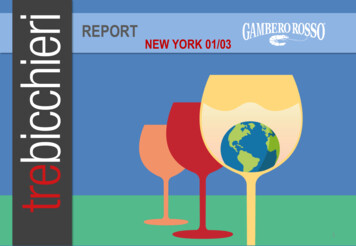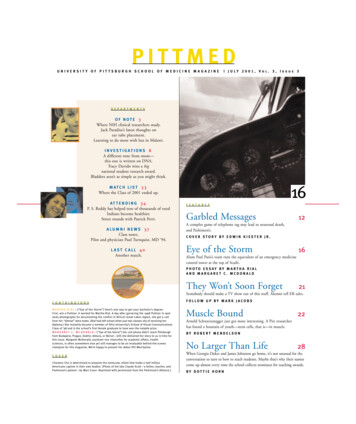Transcription
Editorial ConsultantsCHEN Xiao-ya, ChinaCHEN Zong-mao, ChinaCHENG Shun-he, ChinaDAI Jing-rui, ChinaFU Ting-dong, ChinaGAI Jun-yi, ChinaGUAN Chun-yun, ChinaGUO Yu-yuan, ChinaLI Zhen-sheng, ChinaLIU Xiu-fan, ChinaLIU Xu, ChinaLV Fei-jie, ChinaRONG Ting-zhao, ChinaSHAN Lun, ChinaWU Chang-xin, ChinaWU Wei-hua, ChinaXIANG Zhong-huai, ChinaXIE Lian-hui, ChinaXU Ri-gan, ChinaYU Zhen-wen, ChinaYUAN Long-ping, ChinaZHAI Hu-qu, ChinaZHANG Qi-fa, ChinaZHU Ying-guo, ChinaFANG Zhi-yuan, ChinaMichael T. Clegg, USAChairmanLI Jia-yang, ChinaVice ChairmanZHAO Fang-tian, ChinaEditor-in-ChiefWAN Jian-min, ChinaAssociate Editor-in-ChiefCHEN Huan-chun, ChinaCHEN Jian-ping, ChinaCHEN Wen-fu, ChinaKANG Shao-zhong, ChinaLIN Hong-xuan, ChinaSUN Tan, ChinaTANG Hua-jun, ChinaWU Kong-ming, ChinaYU Shu-xun, ChinaZOU Rui-cang, ChinaExecutive Editor-in-ChiefShu Geng, USAAssociate Executive Editor-in-ChiefLU Wen-ru, ChinaEditor-in-Chief for ColumnsCAO Jia-shu, ChinaFAN Sheng-gen, ChinaHUANG Ji-kun, ChinaJIA Ji-zeng, ChinaKANG Zhen-sheng, ChinaLI Zhi-kang, ChinaLIU Shu-sheng, ChinaMEI Xu-rong, ChinaMENG Qing-xiang, ChinaTONG Guang-zhi, ChinaWEI Yi-min, ChinaXU Ming-gang, ChinaYANG Jian-chang, ChinaZHAO Chun-jiang, ChinaZHAO Ming, ChinaDafen Hui, USAGert H. J. Kema, The NetherlandsReza Keshavarz-Afshar, USAG. S. Khush, USAThomas Kuehne, GermanyJiban K. Kundu, CzechSang-Soo Kwak, KoreaWilliam B. Lacy, USAChangsheng Li, USAZhigang Li, USAZhongchi Liu, USAGabor Lovei, DenmarkHong Luo, USAJ. F. Maestre-Valero, SpainSilvano Mignardi, ItalyMartin Nyachoti, CanadaJairo A. Palta, AustraliaL. S. Pereira, PortugalDragan Perovic, GermanyDaniel Plaza-Bonilla, SpainRuijun Qin, USADaniel Rodriguez, AustraliaScott Rozelle, USAAmir Sadeghpour, USAA. Z. M. Salem, MexicoJames N. Seiber, USASatoru Shimokawa, JapanTatsuhiko Shiraiwa, JapanClinton C. Shock, USAGuy Smagghe, BelgiumQijian Song, USAB. A. Stewart, USAToi John Tsilo, South AfricaRoberto Tuberosa, ItalyNeal K. Van Alfen, USAEric Van Ranst, BelgiumEnli Wang, AustraliaYuxi Wang, CanadaMartin Wiesmeier, GermanyWen-Gui Yan, USAHaishun Yang, USABing Yang, USAJohn Z. Yu, USAXiaohua Yu, GermanyXiao-Qiang Yu, USAXiaoxian Zhang, UKYunde Zhao, USAChen Zhong, SingaporeKun Yan Zhu, USAMembersMauro Antongiovanni, ItalyPeter Carberry, AustraliaKenneth Cassman, USAKenneth Chan, AustraliaNancy Chau, USAPengyin Chen, USADavid Connor, AustraliaNicolas Desneux, FranceIan Dodd, UKYong-ping Duan, USAoec. troph. Klaus Eder, GermanyRalf-Udo Ehlers, GermanyDavid Deqiu Fang, USAShui-zhang Fei , USAAdele Finco, ItalyWolfgang Friedt, GermanyZhi-feng Gao, USAMatthew Gorton, UKManje Gowda, GermanyDavid B. Hannaway, USAJerry L. Hatfield, USAThomas Herzfeld, GermanyJean-François Hocquette, FranceGerrit Hoogenboom, USAYinghua Huang, USABAI You-lu, ChinaBI Yang, ChinaBIAN Xin-min, ChinaCAI Hui-yi, ChinaCAI Xue-peng, ChinaCAI Zu-cong, ChinaCAO Hong-xin, ChinaCAO Wei-xing, ChinaCHEN Fu, ChinaCHEN Hua-lan, ChinaCHEN Kun-song, ChinaCHEN Wan-quan, ChinaCHEN Xue-xin, ChinaCHEN Yan-hui, ChinaCHEN Yong-fu, ChinaCHEN Zhi-qiang, ChinaCHENG Shi-hua, ChinaDIAO Qi-yu, ChinaDING Yan-feng, ChinaDONG Han-song, ChinaDONG Jin-gao, ChinaDONG Shu-ting, ChinaDU Li-xin, ChinaDU Yong-chen, ChinaDUAN Ai-wang, ChinaFAN Xiao-lin, ChinaFENG Shu-tang, ChinaGAO Xi-wu, ChinaGU Yi-kang, ChinaGUO Pei-guo, ChinaGUO Wen-shan, ChinaGUO Ze-jian, ChinaHAN Zhao-jun, ChinaHAN Zhen-hai, ChinaHE Chen-yang, ChinaHE Guo-qing, ChinaHE Zhong-hu, ChinaHOU Xiang-yang, ChinaHOU Xi-lin, ChinaHU Dong-wei, ChinaHUANG Dan-feng, ChinaJIANG Li-xi, ChinaJING Rui-lian, ChinaJU Xiao-tang, ChinaKONG Xian-gang, ChinaLI Bao-guo, ChinaLI Chun-jian, ChinaLI Fei, ChinaLI Jian-sheng, ChinaLI Jiu-sheng, ChinaLI Li-hui, ChinaLI Shao-kun, ChinaLI Sheng-xiu, ChinaLI Shi-qing, ChinaLI Wen-bin, ChinaLI Xiang-lin, ChinaLI Xin-hai, ChinaLI Yu, ChinaLI Zhao-hu, ChinaLI Zhong-pei, ChinaLIN Er-da, ChinaLIN Jiao-jiao, ChinaLIN Min, ChinaLIN Qi-mei, ChinaLIN Wen-xiong, ChinaLIU Da-qun, ChinaLIU Qing-chang, ChinaLIU Tong-xian, ChinaLIU Zhi-yong, ChinaLOU Yong-gen, ChinaLU Cheng-ping, ChinaLU Tie-gang, ChinaLUO Shi-ming, ChinaLUO Xu-gang, ChinaLÜ Jia-ping, ChinaMA Rui-kun, ChinaMA Yue-hui, ChinaMA Zhi-ying, ChinaMENG Xian-xue, ChinaMU Tai-hua, ChinaPAN Gen-xing, ChinaPAN Guang-tang, ChinaPENG Ke-mei, ChinaPENG You-liang, ChinaPENG Yu-fa, ChinaQIAN Ke-ming, ChinaQIAN Qian, ChinaQIANG Sheng, ChinaQIN Fu, ChinaQIU De-wen, ChinaQIU Guo-yu, ChinaQIU Jian-jun, ChinaQIU Li-juan, ChinaREN Tu-sheng, ChinaSHAO Ming-an, ChinaSU Yi-rong, ChinaSUN Qi-xin, ChinaSUN Ri-fei, ChinaWAN Fang-hao, ChinaWAN Jian-min, ChinaWANG Bo-lun, ChinaWANG Cai-lin, ChinaWANG Chen-zhu, ChinaWANG Dong-yang, ChinaWANG Han-zhong, ChinaWANG Ji-hua, ChinaWANG Kun-bo, ChinaWANG Li-xian, ChinaWANG Qiang, ChinaWANG Wen-sheng, ChinaWANG Xiao-mei, ChinaWANG Xiao-wu, ChinaWANG Xi-feng, ChinaWANG Xue-de, ChinaWANG You-ping, ChinaWANG Zhi-min, ChinaWANG Zhi-qiang, ChinaWANG Zong-hua, ChinaWEI Qin-ping, ChinaXIA Guang-min, ChinaXIE Bi-jun, ChinaXIE Cong-hua, ChinaXIE Guan-lin, ChinaXU Jian-long, ChinaXU Ning-ying, ChinaXU Wei-hua, ChinaXU Yun-bi, ChinaXUE Fei-qun, ChinaYANG Han-chun, ChinaYANG Ning, ChinaYE Gong yin, ChinaYE Xing-guo, ChinaYIN Hong, ChinaYIN Jun, ChinaYU Da-zhao, ChinaYU De-yue, ChinaYU Jing-quan, ChinaZHANG Ai-min, ChinaZHANG Bao-shi, ChinaZHANG Chao-xian, ChinaZHANG Fu-suo, ChinaZHANG Guo-ping, ChinaZHANG He-ping, ChinaZHANG Jian-hua, ChinaZHANG Jin-song, ChinaZHANG Ming-kui, ChinaZHANG Shi-huang, ChinaZHANG Tian-zhen, ChinaZHANG Wei-li, ChinaZHANG Xian-long, ChinaZHANG Xue-yong, ChinaZHANG Zeng-yan, ChinaZHAO De-ming, ChinaZHAO Jiu-ran, ChinaZHAO Kai-jun, ChinaZHENG Feng-tian, ChinaZHENG Yong-lian, ChinaZHENG Yong-quan, ChinaZHENG You-liang, ChinaZHONG Fu-ning, ChinaZHOU Chang-yong, ChinaZHOU Guang-hong, ChinaZHOU Ming-guo, ChinaZHOU Wei-jun, ChinaZHOU Xue-ping, ChinaZHOU Zhi-guo, ChinaZHOU Zhi-qin, ChinaZHU De-feng, ChinaZHU Hua-bin, ChinaZHU Li-huang, ChinaZHU Yan, ChinaZHU Zhu-jun, ChinaZHUANG Jie-yun, China
Journal of Integrative Agriculture 2016, 15(7): 1584–1594Available online at www.sciencedirect.comScienceDirectRESEARCH ARTICLETracking domestic ducks: A novel approach for documenting poultrymarket chains in the context of avian influenza transmissionChang-Yong Choi1, 2, John Y Takekawa2, 3, XIONG Yue4, LIU Ying4, Martin Wikelski5, 6, George Heine6,Diann J Prosser7, Scott H Newman8, John Edwards9, 10, Fusheng Guo9, Xiangming Xiao1, 111Department of Microbiology and Plant Biology, Center for Spatial Analysis, University of Oklahoma, Norman, OK 73019, USA2Western Ecological Research Center, U.S. Geological Survey, Vallejo, CA 94592, USANational Audubon Society, San Francisco, CA 94104, USA4Key Laboratory of Poyang Lake Wetland and Watershed Research, Jiangxi Normal University, Nanchang 330022, P.R.China5Department of Migration and Immuno-Ecology, Max Planck Institute for Ornithology, Radolfzell D-78315, Germany6Department of Biology, University of Konstanz, Konstanz D-78457, Germany7Patuxent Wildlife Research Center, U.S. Geological Survey, Beltsville, MD 20705, USA8Emergency Center for Transboundary Animal Diseases (ECTAD) Vietnam Office, Food and Agriculture Organization of the UnitedNations, Hanoi 10000, Vietnam9Emergency Center for Transboundary Animal Diseases (ECTAD) China Office, Food and Agriculture Organization of the UnitedNations, Beijing 100600, P.R.China10Murdoch University, Murdoch, WA 6150, Australia11Institute of Biodiversity Sciences, Fudan University, Shanghai 200433, P.R.China3AbstractAgro-ecological conditions associated with the spread and persistence of highly pathogenic avian influenza (HPAI) arenot well understood, but the trade of live poultry is suspected to be a major pathway. Although market chains of livebird trade have been studied through indirect means including interviews and questionnaires, direct methods have notbeen used to identify movements of individual poultry. To bridge the knowledge gap on quantitative movement andtransportation of poultry, we introduced a novel approach for applying telemetry to document domestic duck movementsfrom source farms at Poyang Lake, China. We deployed recently developed transmitters that record Global PositioningSystem (GPS) locations and send them through the Groupe Spécial Mobile (GSM) cellular telephone system. For thefirst time, we were able to track individually marked ducks from 3 to 396 km from their origin to other farms, distributionfacilities, or live bird markets. Our proof of concept test showed that the use of GPS-GSM transmitters may provide direct, quantitative information to document the movement of poultry and reveal their market chains. Our findings providean initial indication of the complexity of source-market network connectivity and highlight the great potential for futureReceived 30 June, 2015 Accepted 4 January, 2016Chang-Yong Choi, E-mail: subbuteo@hanmail.net;Correspondence Xiangming Xiao, Tel: 1-405-3258941,E-mail: xiangming.xiao@ou.edu 2016, CAAS. Published by Elsevier Ltd. This is an openaccess article under the CC BY-NC-ND license )doi: 10.1016/S2095-3119(15)61292-8
Chang-Yong Choi et al. Journal of Integrative Agriculture 2016, 15(7): 1584–15941585telemetry studies in poultry network analyses.Keywords: avian influenza, domestic duck, market chain, network, poultry, telemetry1. IntroductionAvian influenza (AI) is an infectious disease of poultry andwild birds caused by type A influenza viruses, and theseviruses are classified as low pathogenic (LPAI) or highlypathogenic (HPAI) depending on their virulence in domesticchickens (FAO 2007). Wild waterbirds may serve as naturalhosts or reservoirs for LPAI viruses that do not commonlycause severe clinical symptoms (FAO 2007; Lebarbenchonet al. 2010). In contrast, HPAI viruses of subtypes H5 andH7 may infect poultry and cause disease outbreaks andsocio-economic impacts in communities with poultry farming(FAO 2007; Lebarbenchon et al. 2010). HPAI viruses seemto arise in artificial ecosystems including poultry farms,free-ranging duck production areas, and live bird markets(LBMs) rather than in natural ecosystems (Lebarbenchonet al. 2010). Migratory wild ducks may have potential totransmit the virus during migration by shedding viruses aftersurvival from infection or while asymptomatic (Chen et al.2006; Gaidet et al. 2010; Cappelle et al. 2014), but HPAIis mainly referred as a disease of domestic poultry thatspreads and persists within artificial systems (Gilbert et al.2007, 2008; Lebarbenchon et al. 2010).The Asia-Pacific region has been regarded as an epicentre of new emerging infectious diseases because of the highhuman densities, intensive livestock production with limitedbiosecurity, and close association of livestock and humanhabitation (Shortridge and Stuart-Harris 1982; Jones et al.2008; WHO 2011). Southern China has been suggestedas a hotspot for novel AI emergence and pandemic risks(Webster et al. 2006; Jones et al. 2008; Fuller et al. 2013),and HPAI H5N1 emerged in southern China (Li et al. 2004;Chen et al. 2006; FAO 2007; WHO 2015) in an area whererice farming provides feeding habitat for both free-grazingdomestic ducks as well as wild and migratory birds (Takekawa et al. 2010). Domestic ducks are believed to be the mostimportant hosts that shed HPAI (Sturm-Ramirez et al. 2005;Gilbert et al. 2007, 2008), and high densities of free-grazingdomestic ducks have been associated with HPAI H5N1persistence and transmission (Olsen et al. 2006; Gilbertet al. 2007, 2008; Xiao et al. 2007; Cappelle et al. 2014).To better understand the transmission risks of HPAI, information is needed on spatial distribution and movementsof three key components: wild birds, poultry, and humans.Poyang Lake, the largest freshwater lake in China, has allof the risk factors for transmission (Gilbert et al. 2007, 2008;Takekawa et al. 2010; Wang et al. 2013; Cappelle et al.2014), but detailed agro-ecological conditions associatedwith HPAI spread and persistence are still largely unknown(Gilbert et al. 2007). While agricultural summaries andlocal statistics have been used to derive information onthe distribution of poultry (Wang et al. 2013; Cappelle et al.2014), little information exists on the movements of poultryfrom farms in this region to the markets where they are sold(but see Martin et al. 2011b).Most poultry are sold through LBMs in southern China,and concerns about LBMs in the epidemiology of HPAI haveincreased since the first report of human H5N1 infectionin Hong Kong (Webby and Webster 2001). In LBMs, livepoultry from large catchment areas are intermixed, and thebirds are traded to other markets that results in a networkof trade connections (Gilbert et al. 2014). These networksfavor persistence of virulent strains with continuous circulation of avian influenza viruses between connected farmsor markets (Lebarbenchon et al. 2010; Fournié et al. 2013).Several studies have explored poultry movements throughmarket chains in Cambodia (Van Kerkhove et al. 2009;Fournié et al. 2012), Vietnam (Soares Magalhães et al.2010; Fournié et al. 2012, 2013), and China (Martin et al.2011b) through use of indirect methods including interviewsand questionnaires. However, very little information hasbeen available from direct documentation of poultry movements from source producers through their market chainsin this region.In the past few decades, Global Position System (GPS)telemetry has been used as an effective tool for trackingdetailed movements of wild animals in remote or inaccessible areas. Satellite transmitters also have been used instudies of wild birds in AI studies (FAO 2007; Takekawa et al.2010; Cappelle et al. 2014), but only one previous study hasapplied transmitters on poultry (Prosser et al. 2015), andthose were short-duration loggers (2–3 days) that requiredrecapturing the birds on the farms where they were marked.In this study, we introduced a novel application to mark domestic ducks with recently-developed transmitters that usethe Global System for Mobile Communications or GroupeSpécial Mobile (GSM) to transmit GPS high-quality locationdata without requiring recovery of marked individuals. Wehypothesized that this new technology would allow us totrack individual domestic ducks moving through a marketchain system from source farms to distribution centers,
1586Chang-Yong Choi et al. Journal of Integrative Agriculture 2016, 15(7): 1584–1594markets, and potentially end-users. We proposed a fieldstudy as a proof of concept to document the movement ofpoultry and identify the market chains emerging from thePoyang Lake region.Yangtze RiverJiujiangCityP. R.China2. Materials and methods2.1. Study areaPoyang Lake is the largest freshwater lake in China withextensive wetland ecosystems reaching up to ca. 4 000 km2in the flooding season (Qian et al. 2011). It is located at themiddle reaches of the Yangtze River and is freely connectedto the river in the north (Fig. 1). As a southern terminusand major wintering grounds for wild waterfowl in the EastAsian Flyway, about 425 000 waterbirds (ranging from298 000 to 726 000 in 2003–2008) comprised of ca. 60 species annually visit Poyang Lake during the winter (Qian et al.2011). The lake and its watershed also are well-recognizedas a wetland of international importance for its conservationvalue in hosting internationally threatened wild migratorywaterbirds (Qian et al. 2011). At the same time, this areasupports approximately 10 million people and more than 14million poultry raised by traditional husbandry and tradedthrough LBMs (Takekawa et al. 2010; Wang et al. 2013;Cappelle et al. 2014). These unique environments serveas a melting pot of humans, wild waterbirds, and domesticpoultry, establishing Poyang Lake as a key area of concernfor several strains of avian influenza transmission at thewild bird-poultry interface including: H5N1 in poultry andwild birds (Martin et al. 2011a; Prosser et al. 2013), H5N1and H3N2 in humans (Fuller et al. 2013), H7N9 in humansand poultry (Gilbert et al. 2014), and H10N8 in humans(García-Sastre and Schmolke 2014). For this study, weworked with poultry farmers in the southern and southwestern regions of Poyang Lake where poultry and wild birdsare more abundant and may commonly interact. We visitedfive counties and three cities around the lake; these wereNanchang, Jinxian, and Xinjian counties near NanchangCity, Yugan County near Shangrao City, and Yongxiu Countynear Jiujiang City (Fig. 1).cause of their greater likelihood of entering the market chainwithin the lifespan of transmitters. However, ongoing AIoutbreaks in the study area and lower commercial profit forbroilers during our study limited the number of cooperatingfarms with free-ranging broilers. Thus, we also includedlayers, caged ducks, and other varieties such as muscovyducks (Cairina moschata) and domesticated wild mallards(Anas platyrhynchos) (see Appendix). We included severalvariables including coordinates and size of farms wheretransmitters were deployed, farming type, poultry speciesand numbers, expected date of sale, and body mass ofmarked ducks.2.2. Farm and duck selection2.3. Transmitter deployment and analysisWe visited duck farming areas in the five counties from8–18 January, 2015. The criteria for selecting farms were:1) farms with owners that would cooperate with our studygoals, and 2) farms that planned to sell their ducks beforeLunar New Year. Because layers go to markets largelybased on timing of egg production and not for food for theLunar New Year, our primary target species were domesticducks (Anas platyrhynchos domesticus; including severallocal breeds) raised as broilers. Broilers were selected be-Previous reports suggested that broiler production typicallypeaks during the month of January just prior to the LunarNew Year (Gilbert et al. 2007, 2008; Van Kerkhove et al.2009). We conducted our field work from 8 January to 4February 2015, 2–6 weeks prior to the Lunar New Year (19February in 2015), because the transmitter battery wasexpected to last up to 2 months after deployment under anideal condition. One of our test transmitters lasted for 66days and produced 194 GPS fixes. We estimated the dailyYongxiuPoyang LakeXinjianYuganNanchang CityShangraoCityNanchangJinxian010 2040kmFig. 1 Study area of domestic duck movements at PoyangLake, Jiangxi Province, China. Black dots indicate farms wheretransmitters were deployed.
Chang-Yong Choi et al. Journal of Integrative Agriculture 2016, 15(7): 1584–1594translocation probability as the proportion of the number oftranslocation events to the total number of telemetry-days(768 days total) and used a Poisson distributions to estimateits 95% confidence interval (CI; Dobson et al. 1991).The GPS-GSM transmitter (Konstanz University, Konstanz, Germany) developed for this study is box shaped(39 mm 25 mm 14 mm) with four harness mounts at thecorners and a flexible 45 mm external antenna. Its totalmass of 17 g was approximately 0.9% of a ducks’ body mass(0.4–1.4%). The GPS-receiver consists of a u-blox CAM-M8chip antenna module with a hot-start sensitivity of –156 dBm.The data link to the cellular phone networks is provided bya u-blox SARA-U2 UMTS/HSPA/GSM module. We useddata-transmission via Short Message Service (SMS), andeach SMS had six complete GPS data points with date andtimestamp, coordinates, height above sea-level, time to fix,satellites detected, battery-voltage, index of measurement,and speed. For control, we use an ATMEL-ATXMEGA-A4Uprocessor and a flash 8 Mbyte data-memory. Coordinatesand associated information were collected and stored in thetransmitters and transmitted through GSM cellular phonenetworks to a central station in Germany and from thereto Movebank (http://www.movebank.org). We determinedcommercial trade and local movements of ducks based ontransmitted data including sequential changes in spatiallocations, required time for the first GPS fix, and voltagechanges of batteries over time. The duty cycle was set totake three GPS fixes (Coordinated Universal Time 00:00,12:00, and 13:00 h; local time 08:00, 20:00, 21:00 h) withone data transmission per day. To power the tag, we useda 240 mAh rechargeable lithium-polymer cell balancing thetrade-off between longer lifespan and better concealment.The cost per transmitter unit was about 80 USD.For harnessing, we used Teflon ribbon (70–100 cm inlength, 8.4 mm in width) with two loops for the breast and belly.Transmitters were hidden as much as possible under thedorsal body feathers to minimize chance of human detection.1587Some transmitters on smaller ducks were visible at a closerange, but we expected that marked individuals would bedifficult to identify within a large flock (Fig. 2). Even thoughfarmers agreed to participate in our study and transmitterswere well concealed on selected ducks, transmitters couldbe detected and removed when ducks were captured andsold to a trader or customer. To recover transmitters andcollect end-user information, we placed a label on eachtransmitter with local contact information written in Chinese.Outliers of GPS fixes were filtered out through visualreview. To estimate the home range of tracked ducks, weused ArcMet 10.2 in ArcGIS 10.2 (ESRI, Inc., Redlands,CA, USA) for calculating a MCP (minimum convex polygon)home range for each duck, and we excluded ducks thatfewer than seven fixes within one week. We used Oriana4 software (KCS 2011) for analysis of directional data.2.4. Ethics and repository of tracking dataProcedures for this field research were approved by Institutional Animal Care and Use Committee of the Universityof Oklahoma (AUS R12-004). Tracking data from thisstudy are publicly accessible in the Movebank Data Repository (www.datarepository.movebank.org under the doi.10.5441/001/1.38f467s7).3. Results3.1. Telemetry overviewWe investigated 54 farms with 100-20 000 ducks in fivecounties of the Poyang Lake region, and we selected 28farms where owners were supportive of our work and mostbirds were expected to be sold before the Lunar New Yearholiday. The 28 farms selected for our study had similarnumbers of poultry (mean SD: 2 300 3 700, median: 1 500,n 28) that were not significantly different (Mann-WhitneyFig. 2 Global Positioning System-Groupe Spécial Mobile (GPS-GSM) transmitters deployed on upper back of small (left; #4117,1.8 kg) and large (right; #4156, 2.5 kg) domestic ducks. The white case of the transmitter is not fully covered by contour feathersin the smaller mottled duck, while the transmitter is rarely visible under the feathers of the larger white Peking duck.
Chang-Yong Choi et al. Journal of Integrative Agriculture 2016, 15(7): 1584–15943.2. Market chainWe were able to track the market chain of nine markedducks transported to other farms, distribution facilities,or markets (Fig. 4, Table 1). Although we expected anincreased demand for broilers prior to the Lunar New Year,we found no difference in transportation probability for ducksby market type (6 of 24 or 25% of broilers and 3 of 16 or19% of layers; Fisher’s exact test, P 1.00). Therefore, thedaily translocation probability of each duck was estimatedto be 1.2% (95% CI: 0.54–2.22).Layer #4162 and broiler #4175 were transported to wholesale live bird markets in Nanchang and Jingdezhen, whilebroiler #4171 went to a traditional, local retail market. Broiler#4175 went through a distribution center with 2-day layover(Fig. 4, Table 1). After #4162 was sold to a LBM, the ownerreplenished his farm with another flock of layers including#4161 which had been raised at one of his other farms.Three ducks were tracked until they reached distributioncenter buildings in Jingdezhen (broiler #4170) and Liushui,Zhejiang Province (layer #4188) or to a temporary distribution holding pond (broiler #4152; Fig. 4, Table 1). Broiler#4170 was transported with #4175, but its signal was lostonce it reached the distribution facility. Transmission fromlayer #4188 was lost soon after its arrival to a distributionfacility, but broiler #4152 transmitted for 30 days.The fate and destination of the remaining two ducks wasunclear, because the transmitters appeared to have beenremoved (Fig. 4, Table 1). Broiler #4156 was located ona highway bridge in the northernmost boundary of JiangxiProvince. Although we were unable to retrieve the transmitter, it was abandoned on a typical route to northern provinces1.33Voltage 1/18/01 18/101 8/101 9/101 9/101 9/201 0/201 0/01 20/201 1/201 1/201 1/201 2/201 2/201 2/201 3/01 23/201 3/201 4/201 4/24U 742.0, P 0.90) from the average number found on farmssurveyed in the region (mean SD: 2 350 3 500 ducks, median: 1 600, n 54). We deployed 40 GPS-GSM transmitterson 24 broilers and 16 layers from the 28 farms (Figs. 1–2,Appendix). One duck was sampled from each of 20 farms,but in eight farms, two to five ducks were chosen to examinevariation in movements of individuals from the same farm.A total of 1 376 GPS fixes from 659 messages wereobtained during the period from 8 January to 18 February2015. Transmitters provided 34.4 23.6 fixes (range: 2–99)and 16.5 7.5 transmissions (range: 1–34) over 19.2 8.5days (range: 1–35). Voltage of transmitter batteries declinedfrom 1.34 to 1.24 V through the study, and the time untilthe first GPS fix ranged between 30 and 400 s. Ducks thatwere kept indoors or inside shelters required a longer timefor the first GPS fix resulting in more rapid battery drainage(Fig. 3). Although we placed labels including our contactinformation on transmitters, none of 40 deployed tags wasreturned for inspection.Time to first fix (s)1588Date (mon/d)Fig. 3 Example of changes in battery voltage and time takenby the transmitter to acquire the first GPS fix in field tests. ThisGPS transmitter on a broiler #4117 showed repeated peaks inthe time to obtain first coordinates (first fix per set of readings),suggesting that the first or last daily fixes of the free-rangingduck were usually obtained inside its shelter before release inthe morning or after it was placed in an enclosure in the evening.(such as Hubei and Anhui provinces), and there were nopoultry farms, markets, or end-users nearby. Broiler #4186was located in shrubs and croplands nearby a residentialarea where we suspected that it was sold to a family or localretail shop that was located 9 km away from its source farm.Transport distances ranged from 3 to 396 km (mean SD:(90.2 125.9) km), and the overall heading for duck movements was non-directional (mean direction: 111.5 , weightedmean direction: 82.9 ; Rayleigh’s Z 0.374, P 0.70), although eastward movements were more common (Fig. 5).Layer #4188 and broiler #4156 were documented crossingthe provincial border, while the other ducks remained withinJiangxi Province.3.3. Movements of domestic ducksWe also identified four general movement patterns in GPStracked domestic ducks: caged ducks, free-ranging ducksreturning most nights to a shelter, and area-restricted orunrestricted free-ranging ducks without a shelter (Fig. 6).The average minimum convex polygon (MCP) for thetracked ducks was (177 900 627 800) m2 (mean SD; median: 6 500 m2, n 38) ranging from 270 to 3080 000 m2 (seeAppendix). Except for two unrestricted, free-ranging ducksowned by one farmer that had extensive home ranges of3 080 000 m2 (#4189) and 2 450 000 m2 (#4135), domesticducks generally moved within restricted areas smaller than418 200 m2 (mean SD: (34 100 83 100) m2, median: 5 600m2, n 36). Free-ranging ducks (mean SD: (291 400 792
Chang-Yong Choi et al. Journal of Integrative Agriculture 2016, 15(7): 1584–15941589Fig. 4 Movement of GPS-tracked domestic ducks carried from source farms where they were marked (indicated with an ) toother farms, live bird markets, or distribution facilities (A, #4161; B, #4186; C, #4152; D, #4171; E, #4162; F, #4156; G, #4170; H,#4175; I, #4188). One bird was transported to a live bird market via a distribution facility shown in the enlarged area of panel H.900) m2; median: 19 300 m2, n 23) had much larger MCPareas than caged ducks (mean SD: (3 850 5 050) m2; median: 2 250 m2, n 15) (Mann-Whitney U 44.000, P 0.001).4. Discussion4.1. GPS-based telemetry for documenting marketchainsGPS transmitters have been adopted to identify trade ornetwork of livestock farming by tracking vehicles. In theRepublic of Korea, vehicles that regularly visit farms or carrydomestic animals and their byproducts (food, waste, beds,and medicine) are required to be equipped and tracked byGPS units under the “Act on the Prevention of ContagiousAnimal Diseases” as amended on 13 Aug 2013 (KoreaAnimal Health Integrated System; http://www.kahis.go.kr)after HPAI and foot-and-mouth disease outbreaks. GPStelemetry also has been used to document movement patterns of large livestock to better understand wildlife-livestockinteractions and disease transmission (i.e., cattle and wildboar; Barasona et al. 2014). However, only recently hasminiaturization of this technology enabled us to examinethe movements of smaller animals. To our knowledge, thisstudy provides the first demonstration of the ability to obtaina detailed record of movements of marked individuals in apoultry market chain.We were able to follow nine domestic ducks as theymoved along the market chain from Poyang Lake, including movements along a route via a distribution facility in adifferent city. Our study was a successful proof of concepttest, but if a larger sample could be deployed, more detailed information could be obtained about market chaindifferences related to the type and breeds of ducks as wellas to characteristics of source farms. Larger farms holdingmore than 10 000 ducks were less likely to cooperate with
yNanchangXinjianXinjianYongxiuYongxiuYon
XIA Guang-min, China XIE Bi-jun, China XIE Cong-hua, China XIE Guan-lin, China XU Jian-long, China XU Ning-ying, China XU Wei-hua, China XU Yun-bi, China XUE Fei-qun, China YANG Han-chun, China YANG Ning, China YE Gong yin, China YE Xing-guo, China YIN Hong, China YIN Jun, China YU Da-zhao










